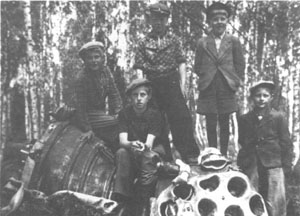
[ Svenska | English ]
During second world war, seven German missiles from the rocket development works in Peenemünde crashed in Sweden. These missiles were captured by the Swedish army and was subject to careful technical examination, which eventually was to become the foundation of the Swedish missile program at SAAB and other Swedish vendors. On this page I try to collect some information about these missiles and their history.
If you want all facts in depth and detailed, I recommend my essay on the subject: The Rocket and I where I take a closer look at the events from my own perspective.

The documentation of these missiles was compiled in a number of military reports written mostly at Flygtekniska Försöksanstalten (FFA, the Defence Aeronautical Experimental Institute) and the naval shipyard at Skeppsholmen in Stockholm. All the reports are nowadays declassified, this normally happens 50 years after the publication date, in out case around 1994.
The V1-Missiles that crashed in Karlskrona, Ystad and Brösarp were carefully studied and documented in these reports (which are in Swedish):

The last PM was probably written as a reaction to some kind of intelligence report from Denmark, which I haven't yet located. It is also a bit confused concerning V1 and V2. Heinrich Himmler had renamed the unmanned glider missile Fi 103 to V1 (Vergeltungswaffe 1, Vengeance Weapon 1), and the rocket missile which actually went by the name A4 was similarly renamed V2. Because of this, Swedish intelligence thought V2 was an improvement over V1, thus a glider aircraft, and as a consequence thereof they believed the rocket that had crashed in Bäckebo to be some kind of totally different weapon. The "new" weapon was thought to be radio controlled, as the V2-rocket in Bäckebo had been full of radio equipment. For this reason the British started to negotiate with Swedish officials in order to setup a radio surveillance station in Ottenby to examine the German weapons.
The Bäckebo rocket was however not representative; it was a test rocket which was controlled from the ground using a joy-stick, and had been constructed withing the Wasserfall-project and targetted for air defence, that is, taking down enemy aircraft. The actual A4-rocket was already finished and in production.
Attached to the report was also a newspaper article from DN (Dagens Nyheter) October 3rd 1944 and articled from "The Illustrated London News" September 16th, and "Aeronautical Engineering" October 6th 1944. All the details of the V1 was disclosed by the English, probably in order to demoralize the Germans.
There were two reports written about the V2-missile. The one below is dated July 21st 1944. It was written by Henry Kjellson with aid from professor Sten Luthander, and in 1946 the report was followed up with another report named Redogörelse över den tyska A4-raketen V2, Rapport över teknisk undersökning av Bäckebo-lufttorpeden which I haven't yet been able to locate.
In the summer 2000 I visited Bäckebo and took a few photographs of the
V2-crater. You can find images and travel directions right
here.

The V2-robot was then sent to London, as Sweden in this phase of the war was increasingly willing to cooperate with the Allies. The transport to England is told to have been attacked by German air defence, as German spies knew about the transport.
The litterature concerning these robots is not very volumnious, but here are some reading hints (mostly in Swedish):
The creator of the page is Linus Walleij.